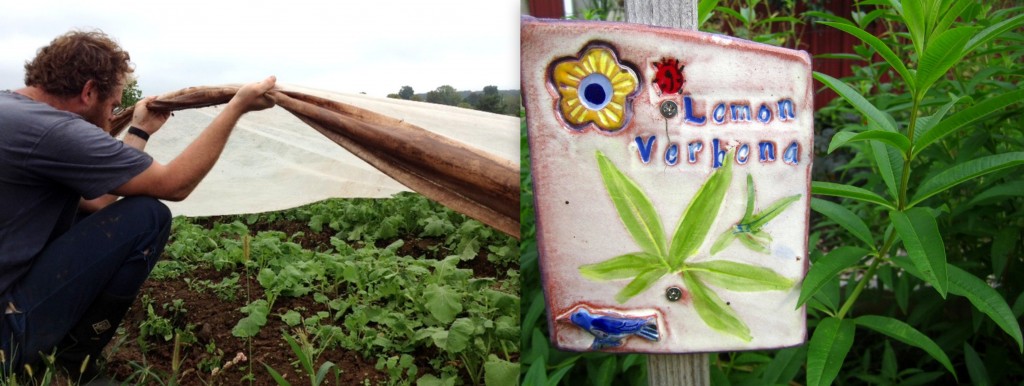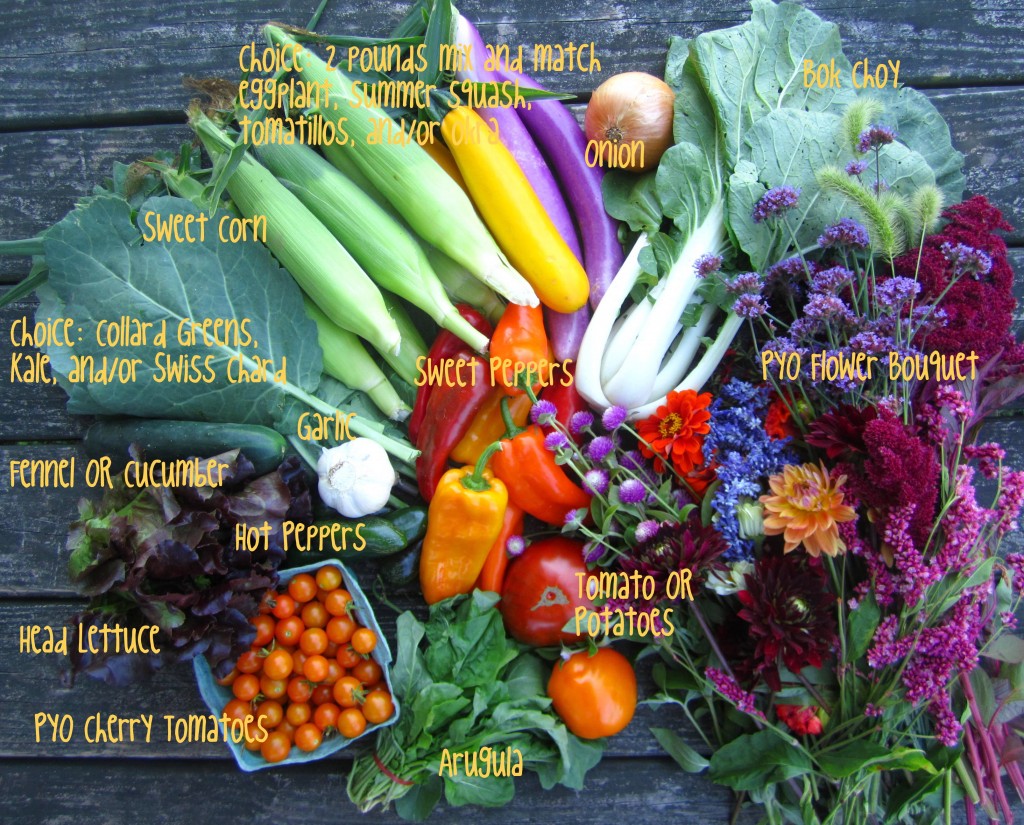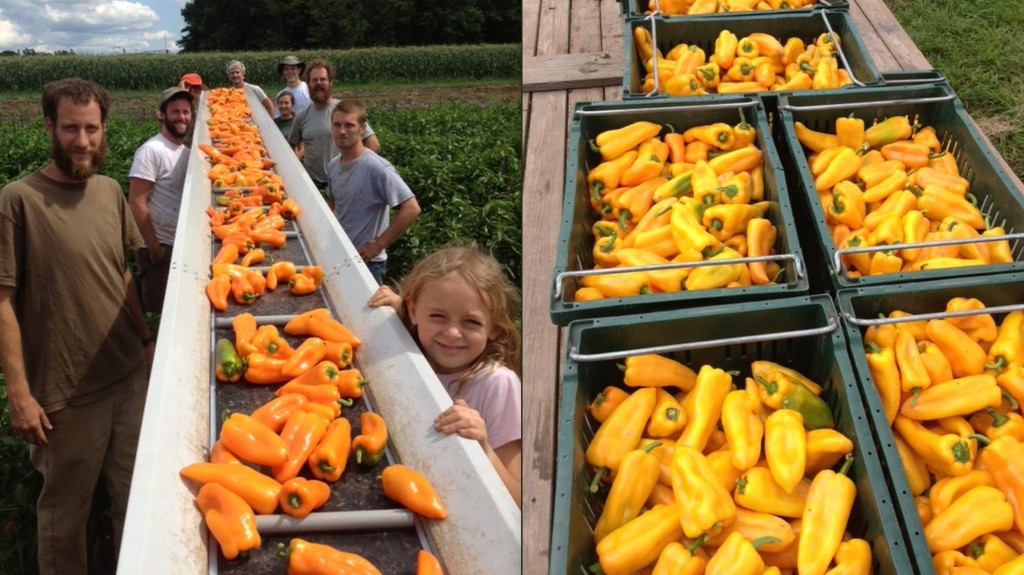13 Sep Green Tomato Frittata
 I always consider green tomatoes a bonus veggie: An unexpected and tasty gift us CSA members get during the summer-fall transition of share season. For the most part, green tomatoes carry much of the same nutritional value as their red counterparts. They’re both very good sources of vitamins A, C, and K, manganese, and potassium, and both deliver health-boosting fiber. Green tomatoes, however, have the added nutritional benefit of being a very good source of the B5 vitamin, pantothenic acid, which is essential in aiding in the metabolizing of carbohydrates, fat, and protein.
I always consider green tomatoes a bonus veggie: An unexpected and tasty gift us CSA members get during the summer-fall transition of share season. For the most part, green tomatoes carry much of the same nutritional value as their red counterparts. They’re both very good sources of vitamins A, C, and K, manganese, and potassium, and both deliver health-boosting fiber. Green tomatoes, however, have the added nutritional benefit of being a very good source of the B5 vitamin, pantothenic acid, which is essential in aiding in the metabolizing of carbohydrates, fat, and protein.
Green tomatoes are firmer than their red buddies, so they hold up nice to pickling, cooking, and baking without turning to mush. They have a tart flavor when eaten raw, which some people don’t prefer, but pairing them with a sweeter veggie like red tomatoes, corn, and/or onion, creates a great sweet-and-sour balance. Green tomatoes bring a brightness to soups, sauces, and salsas, where they also pair well with hot peppers and spices. Of course, fried green tomatoes is probably the dish we’re most familiar with, but green tomatoes actually do really well baked — either as baked green tomatoes or in savory breads and biscuits. The recipe below is probably my favorite green tomato recipe; it’s a frittata suitable for a quick breakfast, lunch, or dinner. Check out the links below for more green tomato nutritional info and links to other yummy recipes!
References and recommended links:
- Green tomatoes’ full nutritional profile is on the Nutrition Data website.
- Green tomato nutrition, selection, and storage tips at the Produce for Better Health website.
- Here’s a recipe for a Green Tomato and Swiss Chard Gratin at NY Times.
- Easy-peasy, no-cook pickled green tomatoes recipe at In the Garden.
- This Spaghetti con Pomodori Verdi (spaghetti with green tomatoes) recipe from Mario Batali uses lots of fresh herbs and arugula.
- This recipe for Green Tomato And Pimento Cheese Biscuits sounds delicious (be sure to use a whole wheat version of the flour).
Ingredients
1-1/2 green tomatoes, sliced about 1/4″-1/2″ inch thick, lightly sprinkled with salt and pepper
1/2 green tomato, chopped fine (about 1/2 cup)
1 frying pepper, chopped fine (about 1/2 cup)
1 poblano pepper, chopped fine (about 1/2 cup)
1 small onion, chopped fine
1/2 cup cornmeal for dredging
3 garlic cloves, minced
2-3 tablespoons fresh herbs (basil, parsley, chives, and/or thyme are all good here)
10 large eggs
Salt and pepper to taste
Cooking spray
Method
Preheat oven to 400-degrees.
Dredge tomato slices in cornmeal. Coat a large oven-safe skillet (cast iron works great) with cooking spray and fry each tomato slice for 2 minutes. Spray tomato again, and flip, frying again for 2-3 minutes. Set slices aside, and wipe pan clean. Spray skillet again with cooking spray, add onion, and cook until translucent and soft, about 3 minutes. Add pinch or two of salt and garlic and mix well. Stir in the chopped tomatoes and peppers, and mix until combined well. Season to taste with salt and pepper, and cook, stirring often, until all veggies are softened, about 10 minutes. Stir in fresh herbs.
Meanwhile, beat eggs and season with salt and pepper.
Add egg mixture to skillet, turn heat up to medium-high, and lightly combine the ingredients, allowing the egg to distribute evenly throughout the filling, and making sure there is an egg coating on the bottom of the pan. Place the fried sliced green tomatoes on the top of the frittata. Turn heat down to medium, and cook until edges begin to set, about 3-4 minutes. Place frittata in oven and cook until the center is firmly set, about 12 minutes.
Finish frittata under the broiler until it’s lightly browned, about 3 minutes. Remove from the heat, and allow to cool and set for 10-15 minutes. Loosen the edges with spatula and slice for serving.
Post and photos by Mikaela D. Martin: Blooming Glen CSA member since 2005, board-certified health counselor, and co-founder and -owner of Guidance for Growing, an integrative wellness practice in Souderton. Read more about healthy eating and living on her site, http://guidanceforgrowing.com!


























